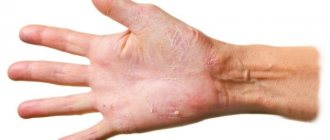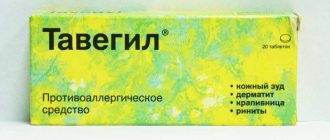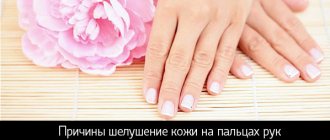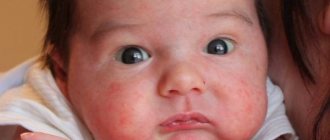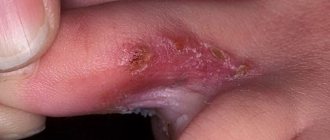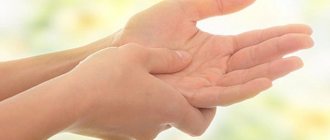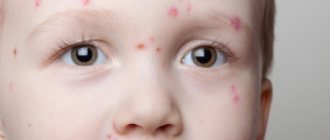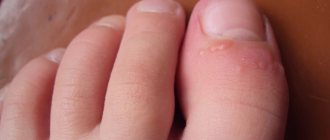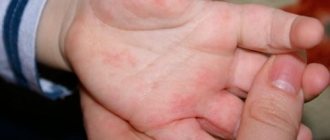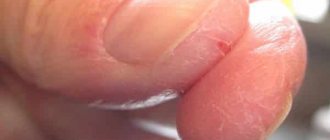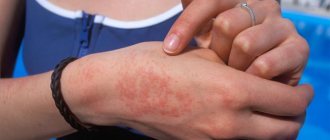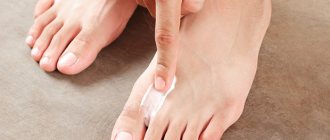Causes
The cause of a symptom such as a rash on a child’s hands depends on various factors. Rashes can be caused by pathogenic microbes, chemicals, mites, or the body’s reactions to allergens.
Allergy
Allergic reaction. The baby may have eaten, touched, or put on something, causing the top layer of skin to react in the form of rashes on the arms, legs, cheeks, or the entire face, neck, butt, abdomen, feet, and chest . Most often, parents do not immediately notice a skin reaction to an allergen, so it is sometimes difficult to determine which object or food is the culprit of the unpleasant symptoms.
The most dangerous thing is prolonged contact with the allergen, the surface of the skin itches, and the number of rashes increases.
Atopic dermatitis
This type of dermatitis is an indicator of the presence of a congenital allergy. In such cases, a rash on the child’s hands appears with frequent contact with a certain allergen. Most often, the allergic rash that appears with this disease is located symmetrically on the skin. It can be found on the legs, face, butt, both hands, elbows, cheeks, stomach, between the legs and on the fingers. The rashes themselves are represented by small blisters.
Blisters of atopic dermatitis may become wet and burst, after which they are covered with a dry crust. It happens that a dry rash itches.
Infections and viruses
Rashes can appear as a result of certain infectious diseases. Basically, the manifestations characteristic of such diseases can be observed primarily on the torso (chest or abdomen), on the hands, wrists and fingers. Parents may notice the rash already at the moment when it spreads to the limbs. However, when infected with the Coxsackie virus, a small red rash will be localized only in the arm area.
Failure to comply with hygiene rules
If a child has a small red rash on his hands , then you should take a closer look at his hygiene after playing outside. After each walk, the child should wash his hands thoroughly. Rashes due to poor hygiene are often accompanied by severe itching.
Parasites
In children's groups, for example, in kindergarten, you can often find a parasite that causes scabies. The disease is spread by the scabies mite, which is transmitted from an infected child through the touch of hands, as well as through objects that he used. With this disease, rashes can be observed between the fingers . The child is bothered by severe itching. With scabies, the rash appears in the form of blisters, small plaques and pimples.
If a parasitic infection of the skin of the hands is detected, the doctor prescribes immediate treatment.
Nervous
Prolonged and severe stress can provoke a rash, which is of a nervous nature. Similar rashes are observed on the legs, face, butt, cheeks, stomach, neck, chest and arms . These rashes are accompanied by itching at a time when the child is nervous or worried.
Treatment of certain diseases accompanied by acne on the folds
It is very important to accurately determine the cause of the rash in such unusual places, for which you should consult a doctor and undergo an examination. The treatment plan and other actions always depend on the characteristics of the disease and the child’s body.
Psoriasis
The main symptom of this disease is the appearance of acne in the child's elbows. The disease is considered hereditary and can appear not only in childhood. The reasons for its occurrence to this day are not fully understood, but presumably the main factors are frequent stress, metabolic disorders, skin damage with the penetration of pathogenic microorganisms, and the transfer of serious infectious diseases.
Acne in this case is accompanied by peeling of the skin, severe itching, and the rashes gradually merge into large red spots. Such a disease cannot be neglected, since its development can cause serious complications, for example, arthritis or inflammatory processes in the joints.
Treatment in this case is carried out as prescribed by a doctor, and baths with decoctions of medicinal herbs such as celandine, string, chamomile, as well as birch tar, phototherapy and ozone therapy will help alleviate the child’s condition. Depending on the age of the child, the doctor may prescribe hormonal drugs, as well as salicylic or ichthyol ointment, topical preparations containing zinc, and antihistamines.
Atopic dermatitis
If you start an allergic rash without paying attention to it and without taking proper measures to eliminate it, it can easily develop into a form of atopic dermatitis, and almost anything can be an allergen, but for effective treatment it is important to accurately identify the allergen. To do this, doctors conduct a special examination using tests.
In this case, the rash is often localized on the inside of the elbow, on the skin of the wrist, on the bends of the legs, between the fingers, and, if neglected, on almost any part of the body.
The doctor prescribes treatment depending on the child’s condition, his age, and the characteristics of his body. Most often, the treatment plan includes various antihistamines, both systemic and local external use. In some cases, the doctor may prescribe antibiotics.
Eczema
In this case, pimples appear on the folds of the arms and legs, in particular on the inside of the knees and elbows, and at the initial stage of development, such a rash looks like a collection of small blisters under the surface of the skin. If such bubbles are damaged, for example, when scratching to eliminate intense itching, then the release of a viscous liquid can be observed. Quite often, the appearance of eczema in different parts of the body becomes a complication of atopic dermatitis or a serious allergic reaction.
Treatment in this case consists of eliminating the allergen and stopping further contact with it, as well as taking antihistamines and applying local remedies to eliminate itching and inflammation. An excellent method of therapy in such cases is the use of tar ointment.
Granuloma annular
This formation usually appears in children under 10 years of age. In this case, acne appears on the hands between the fingers, on the knees and elbows. The causes of the disease have not been established, but doctors have long noticed that the disease is transmitted along a hereditary line.
However, such rashes usually do not require treatment, since they go away on their own, without creating a danger to human life and health, but the disease is chronic. To quickly eliminate rashes and relieve itching, you can use local ointments prescribed by your doctor.
Mycosis
In this case, acne on the folds of the arms and legs, as well as between the fingers, appears due to the penetration of pathogenic fungi into the skin tissue. The rash is accompanied by severe itching and requires urgent action. For treatment in such situations, local drugs in the form of ointments and creams are usually used, in particular Mikoseptin, Mikozolon, Mifungar. In difficult cases, the doctor may prescribe systemic medications.
Diagnostics
In order to select adequate treatment for a rash on a baby’s hands, the pediatrician needs to diagnose this manifestation of the disease. First of all, the temperature will be measured. After which the patient may be referred to an allergist and dermatologist. Experts will be able to differentiate the disease by appearance. Then additional tests are prescribed.
If an allergic cause of the rash on the hands, which may also be present between the fingers, elbows, legs, face, butt, cheeks, stomach or neck, is not confirmed, the child will be referred to a dermatologist-infectious disease specialist.
First of all, the specialist will ask the parents about the timing of the onset of symptoms of the rash, their probable cause and the measures taken to eliminate the rash. Afterwards the little patient was examined. The doctor performs an examination with a detailed study of the appearance and localization of the rashes, which can be not only on the hands, but also between the toes, face, butt, knees and elbows, cheeks and neck.
Rash between the fingers of a child: what to do, how to treat
If a child has rashes on his arms, this may be a manifestation of a wide variety of pathologies. This article will tell you how to figure out when a child experiences this symptom and what to do about it.
Causes
Doctors identify a huge variety of different provoking factors that contribute to the appearance of various rashes on the hands of children. It can manifest itself in different ways. The severity and course of the disease depends on the initial cause that caused the baby to develop rashes on the skin. Such skin lesions can occur in children at very different ages.
Scabies
The appearance of a rash between the fingers is often a consequence of scabies. In this case, scabies mites lead to the development of this unfavorable symptom in children.
These skin parasites settle in the skin and cause the development of various small rashes on it. It should be noted that scabies is also highly contagious.
Every year a huge number of different outbreaks of this disease are recorded within organized children's groups.
Scabies mites require oxygen to function. To do this, they crawl out from the deep layers of the skin to more superficial ones. This is manifested by the appearance on the skin of multiple small spots that appear at the places where parasites enter and exit to the surface. This clinical sign can also appear on the hands and flexures of the arms.
Allergies
Allergic pathologies also quite often lead to various rashes appearing on clean and healthy children's skin.
This is caused by various allergens that enter and affect the body.
Quite often, the development of skin rashes is promoted by various chemicals, household chemicals and cosmetics, as well as foods that the child eats daily.
Allergic rashes can occur on the hands and feet, as well as on other areas of the skin. As a rule, they are accompanied by severe itching. Its intensity may vary. In some cases, severe itching of the skin brings severe discomfort to the child. It can occur in a child not only during the day, but also at night.
Body temperature in this case may remain within normal limits.
How does it manifest?
The appearance of rashes that appear on the skin of the hands may vary. It depends on what caused the appearance of such specific changes on the skin. Infectious skin pathologies are manifested by the appearance of multiple bright red spots on the skin. This small rash usually itches a lot. Rashes can appear in a child both on the arms and on the stomach.
Staphylococcal flora causes the appearance of multiple blisters on the baby’s skin, filled from the inside with serous or yellow liquid. The severe course of the disease is accompanied by the appearance of pus in such rashes. These skin blisters may burst when touched.
In this case, serous fluid or pus leaks out, and multiple bleeding ulcers remain at the site of the former rash.
A fungal infection occurs in a child with the development of multiple white rashes. In some cases, they may also have a yellowish tint.
Usually the surface of fungal rashes is uneven. On the outside, such skin elements are covered with a large number of easily exfoliated skin scales.
In some cases, the rash may not be intensely colored and may be colorless.
Allergic skin changes that occur on the hands and cheeks are manifested by the appearance of bright red or crimson spots.
This localization is quite common in infants who are beginning to receive their first complementary foods for the first time in their lives. In this case, some food products become allergens.
Quite often, various fruit or vegetable purees that are orange or yellow in color lead to the development of allergies in children.
Large red spots on the arms and neck may be a sign of heat rash . This symptom manifests itself especially clearly in babies in the first months of life. Such “flaming” spots appear in places of direct contact with clothing. The affected areas may also feel warm and moist to the touch.
How to treat?
When various rashes appear on a child’s skin, it is very important to immediately show the child to the attending physician. In many cases, differential diagnosis is a rather difficult task.
A clinical examination alone is not sufficient to establish a correct diagnosis.
Mandatory laboratory tests and, in some cases, instrumental studies are required.
After identifying the cause that contributes to the development of various rashes on the skin of the baby’s hands, doctors prescribe the necessary treatment regimen. The duration of such therapy may vary.
In some cases, it may even take several weeks to achieve a positive effect. During the treatment process, the doctor must monitor the effectiveness of the prescribed therapy.
A clinical examination of the sick child and laboratory tests help him with this.
If the cause of a rash on a child’s skin is a bacterial infection, then doctors resort to prescribing antibacterial drugs .
Typically, mild skin diseases are treated with local treatment. For this, various ointments and creams with antibacterial properties are used.
Only in cases of pronounced and unfavorable development of the pathology are tableted or injectable forms of antibiotics prescribed.
Skin rashes caused by allergies can only be eliminated with the help of antihistamines . Such drugs include: Claritin, Suprastin, Zyrtec and others.
The frequency of use, course and daily dosages, as well as the duration of treatment are determined by the attending physician, taking into account the initial well-being of the baby, as well as his weight and age.
The use of these products not only has a pronounced anti-inflammatory effect, but also reduces skin itching.
To eliminate rashes on a child’s hands caused by a fungal infection, special antifungal agents . They are usually discharged for a fairly long stay.
Compliance with personal hygiene rules while using these drugs is a very important condition for therapy. In most cases, antifungal agents are prescribed in conjunction with immunostimulating drugs.
In some cases, the prescribed treatment does not lead to an improvement in the baby’s well-being. In this situation, the prescription of hormonal drugs is already required. They are prescribed for use in the form of gels, ointments or creams.
This topical treatment usually does not cause many unwanted side effects. These drugs quickly lead to positive results.
Various physiotherapeutic methods are also used to eliminate rashes on the skin of the hands of children . Treatment with ultraviolet rays has been used quite successfully.
Such techniques have a pronounced positive effect on the skin, promoting its cleansing, as well as restoration and healing.
To achieve a lasting positive effect, at least 10-15 procedures may be required.
Kinds
Various diseases can be accompanied by characteristic types of rash, which vary in size, color, shape and nature of its surface. also differ from each other by the presence of contents, for example, fluid or pus . Common types of rash:
- Vesicle , represented by vesicles, is usually filled with liquid and reaches 0.5 cm in diameter. Most often, when it is damaged, a wet patch of skin appears.
- The macula , which looks like a speck, is the part of the skin where color changes have occurred. However, this rash does not rise above the surface of the skin. It can appear not only on the hands, but also on the face, butt, and other areas of the skin.
- The bubble (not to be confused with a bubble) is 0.5 - 2 cm in diameter.
- The blisters are spherical, irregular in shape and look like bubbles. The size of the blisters exceeds 0.5 cm.
- A pustule is an abscess that protrudes above the surface of the skin and is filled with pus.
- A white rash on the hands may indicate the presence of allergic dermatitis. The white rash is initially small in size and occupies small areas of the skin, then begins to spread throughout the body.
Rash on a child's hands
The baby's skin is very delicate and vulnerable. She grows up every day, acquiring more and more new functions, which, by adulthood, will contribute to reliable protection of the body. But what to do if a rash appears on the skin of your baby’s hands? Is this a reason to sound the alarm? More on this later in our article.
What could it be?
A rash on a child's hands can appear for various reasons. In terms of frequency, the leaders are allergic rashes, which “attack” a child after one year of age - this is when the baby begins to become closely acquainted with the outside world, as well as with all the hygiene products with which we come into contact every day.
Next on the list are viral and infectious diseases. Most often, the first signs of a rash appear on the torso or face, and only then spread to the arms and legs. But, since the hands are always visible, it is quite possible that first you will find it on the hands, and only then, carefully examining the child’s skin, you will notice rashes all over the body.
And now more about each of the causes of a rash on a child’s arms.
- Allergic rash on hands. If your baby came into contact with a new hand soap, shampoo, or other hygiene product, after which a rash appeared, it is not difficult to guess the cause. But, unfortunately, most often, a rash appears on a child’s hands a few days after starting to use the allergenic product. Therefore, the cause of the occurrence can be difficult to determine. Fortunately, an experienced dermatologist will immediately recognize an allergic rash on your hands and prescribe you the correct treatment.
- Atopic dermatitis. It is generally accepted that atopic dermatitis is hereditary. But in order for the disease to make itself felt, constant contact with the allergen is needed. If you notice a rash on your newborn's hands, redness, and after a few days the appearance of small blisters, your baby most likely has atopic dermatitis. In order to avoid the progression of the disease, you need to follow some rules that will help you prevent your baby from coming into contact with the allergen. Things should be washed with soap or hypoallergenic powder, and the use of all household chemicals should be minimized. There should be no animals in the house, because their dander is the strongest “provocateur”. Do wet cleaning as often as possible, and if you suspect a specific substance, get your child's blood tested to confirm your suspicions. In any case, consultation with a doctor is required, since without proper treatment, atopic dermatitis is complicated by allergic rhinitis and bronchial asthma.
- Viral/infectious causes. Many childhood infections are characterized by rashes all over the body, including on the hands. These include scarlet fever, chickenpox, rubella, measles, impetigo and other diseases. In the first days of the disease, they appear in the torso and face, only after some time they spread to the arms and legs. But there is also a viral infection that primarily manifests itself on the hands - this is the Coxsackie virus. A rash on the arms, on the hands, between the fingers is the first sign of the disease. Also, small blisters may be present on the lower extremities. There is another form of Coxsackie's disease - aphthous tonsillitis. In this case, the arms and legs are not affected, but the throat is actively involved in the process. The virus is very quickly transmitted from one child to another, but can be easily stopped - personal hygiene “kills” it with ease. But if your child has already become infected, know that the treatment of a rash on the hands due to Coxsackie’s disease is quite simple. Bed rest, antipyretics (if necessary), as well as plenty of fluids.
It is important to take a responsible approach to treating hand rashes, especially if your child tends to scratch them. Always remember the risk of infection, which is far from being as harmless as the primary cause of the rash.
Related articles:
| Diathesis on the cheeks of a child The appearance of red spots on the cheeks of a child, diathesis, is usually associated with an allergic reaction to certain foods or other allergens. They cannot be ignored, since diathesis itself is a predisposition to more serious diseases. | Molluscum contagiosum in children - treatment One of the skin viral diseases that often affects children is infection with molluscum contagiosum. This is a fairly serious skin problem and its treatment should be carried out under the supervision of specialist dermatologists. You will learn how molluscum contagiosum is treated in our article. |
| One of the manifestations of chickenpox (chickenpox) in children is the appearance of pimples all over the body. Therefore, parents are faced with whether they need to smear and disinfect them with something and what preparations to use for this. We'll talk about this in our article. | Small rash on the child’s body The baby’s skin is an indicator of his health and well-being. With any changes: negative influences, poor diet or illness, a rash appears on the skin. In our article we will tell you what could be the cause of a small rash in a baby. |
womanadvice.ru
Treatment
After diagnosing the rash, the specialist should prescribe treatment. Parents should not treat rashes on the arms, butt, abdomen and other areas of the skin of a small child on their own, especially if the child has a fever.
Treatment of rashes is divided into two main areas:
- relieving symptoms such as fever and rashes and unpleasant itching;
- treatment of the disease that led to the rash.
Treatment may be required with antihistamines , local agents, which are represented by ointments, creams, gels containing hormones . The rash sometimes has to be treated with injections of drugs or medications taken orally.
- Read in more detail: what different rashes look like
Treatment may involve taking antifungal, antiviral, or antibacterial agents . But don’t forget about taking vitamins that will help strengthen the child’s immune system. And itching can be treated with sedatives and antiallergic cooling gels.
Sometimes the doctor suggests treating a rash on the hands with special ultraviolet lamps, which can be included in physiotherapy. The rays of such devices can destroy bacteria and eliminate acne.
